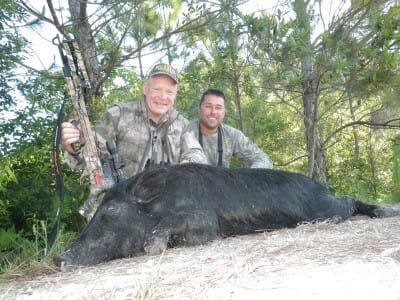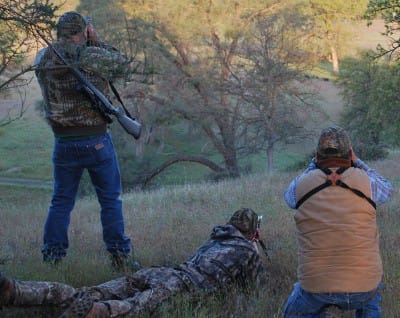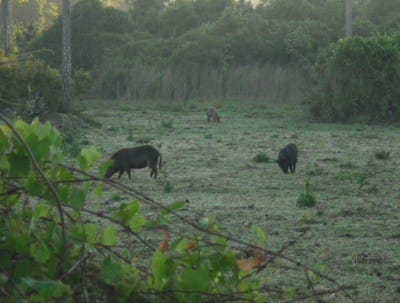
Leupold has a “Pigman” riflescope. Winchester has their new “Razorback” ammuntion… and I suspect this is just the tip of the iceberg. The wild hog is coming on fast as one of American hunters’ favorite pursuits. The wild hog is not native to North America, but is certainly not new. Some populations were established by 17th Century seafarers (if not sooner) so passing ships might find a reliable source for fresh meat. The “Arkansas razorback” is hardly a new mascot, and there are horrific (but true) tales of feral hogs stalking Civil War battlefields.
Hog hunting is also not new. Feral hogs have been hunted at least casually in many areas for many years. Clear back in 1970 Dad and I drove to Tennessee during Christmas break, where we shot our first hogs. In 1974 my first duty station in the Marines was California, where I learned that the wild hog, almost uniquely in the United States, was officially classed a “big game animal,” requiring a license and with seasons and bag limits. The latter two were pretty simple: Year ‘round season, no bag limit. These “restrictions” (or lack thereof) remain in place, but today every pig taken must be tagged. No California hunters like the tagging system, and nonresidents hate it (the tags have gotten pricey, especially for out-of-staters), but California hunters still love their wild hogs; for many years now the wild hog has been the Golden State’s most popular (and thus most important) game animal.
This is also true in Hawaii, where all big game was introduced, and where the wild pigs are the most widespread and most available species. However, I don’t predict that the wild hog will replace the whitetail deer east of the Mississippi, and while there are scattered populations throughout the West, I don’t see the wild hogs taking over from elk and mule deer. On the other hand, wild hogs are expanding their range dramatically. In doing so they are increasing hunting opportunity-a rare phenomenon in our 21st Century-and endearing themselves to hunters.

Some hunters-and especially outfitters trying to sell pig hunts-use a variety of fancy names for our American wild hogs. Ascending examples would include “wild boar,” “Russian wild boar,” and even “imperial wild boar.” I don’t have any problem with calling the male variety a wild boar, but all American populations are properly feral hogs, with at least some (and sometimes all) domestic genes. In the early 20th Century there were two known introductions of pure European wild swine: George Gordon Moore at Hooper’s Bald, North Carolina; and William Randolph Hearst on his ranch at San Simeon, California. In recent years there have been some introductions to improve local populations (at least in appearance), but no North American populations are pure. And what difference does that make? Left on their own, domestic swine revert to the wild very quickly. Tails and ears get straighter, they get hairier, and the shoulders grow more powerful in relation to the hams. Most populations in the U.S. stem from the 19th Century practice of letting swine fend for themselves. They do that just fine, and now they’re all over the place!
Landowners, especially farmers, tend to hate them. They’re hard on crops, and if there are too many of them their rooting can be extremely hard on the land. So it can be a lot easier to get permission to hunt hogs than to hunt deer. This endears them to hunters, but there’s much more. While piglets are incredibly cute (and really smart), there is nothing endearing about a grownup hog. They’re kind of like lawyers: Mean, ugly, nasty, greedy. It’s hard to be sympathetic with lawyers or wild hogs. So they (hogs, not lawyers) are ideal for beginning hunters. I started both my daughters on wild hogs, and neither had hesitation or regret.
Whether a beginner or an experienced hand, there are advantages to hunting wild hogs. The animals are extremely prolific breeders, so in most situations hunting is genuine population management, if not control. A pig is a pig, so there are generally no restrictions and no pressure. Taking a sow helps control the population much better than taking a boar…so in dry years in California we leave the sows alone, and in good times that’s what we seek, because their meat is generally the best. Well, okay, not quite: For eating the best choice is probably a sow or young boar in the 80 to 120-pound range.
The worst is a big, stinky boar. In really good seasons a boar can be okay…but all too often the best you can do is make a spicy sausage. That said, a big boar with good tusks is a much under-rated trophy. Older boars are never a large part of the population, and they are the most elusive and most nocturnal. Boars fight among themselves constantly, so they know exactly how to use those tusks. While many predators pick off piglets, a mature boar has nothing to fear other than man. Unwounded, innate caution takes over and he will evade contact if possible. Hurt him and you have a different deal; he will attack readily if he can.
I’ve hunted California hogs for more than 30 years, and I’ve enjoyed many great hunts and a lot of good pork. I don’t think I’ve ever taken our wild hog for granted, but since I had good pig hunting close to home I haven’t spent a lot of time pursuing them elsewhere. Sure, I’ve run into pigs here and there, enough to realize that they’re extremely adaptable-and we must be as well.

The pigs don’t change much, but we hog hunters have to adapt our techniques to the topography, vegetation, and habits of local pigs.
Just recently this was brought home when, by chance more than design, I hunted pigs in California, Florida, and Texas in a brief period. All hunts were good, but I might as well have been in three different worlds…and yet hunting the same animal. Hog hunting is definitely “in!” Right now it’s the best thing going in big-game hunting, and we’re starting to see an emerging mini-industry and mini-culture just for hog hunters. This is going to be fun to watch, because consider myself one of the charter members!
The Union Sportsmen’s Alliance website is designed to provide valuable articles about hunting, fishing and conservation for members of AFL-CIO affiliated labor unions and all sportsmen and sportswomen who appreciate hunting and fishing and want to preserve our outdoor heritage for future generations. If you would like your own story and experience from the outdoors to be considered for our website, please email us at[email protected].







